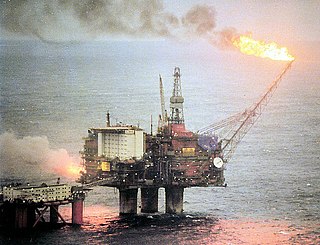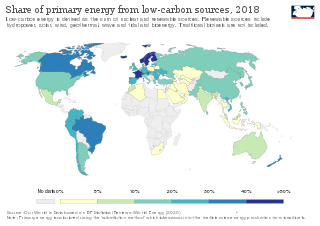
Snøhvit(English: Snow White) is the name of a natural gas field in the Norwegian Sea, situated 140 kilometres (87 mi) northwest of Hammerfest, Norway. The northern part of the Norwegian Sea is often described as the Barents Sea by offshore petroleum companies. Snøhvit is also the name of a development of Snøhvit and the two neighbouring natural gas fields Albatross and Askeladden. Estimated recoverable reserves are 193 billion cubic metres of natural gas, 113 million barrels of condensate, and 5.1 million tonnes of natural gas liquids (NGL). The development comprises 21 wells. The Snøhvit development is operated by Equinor on behalf of six gas companies owning licenses:

A fossil fuel power station is a thermal power station which burns a fossil fuel, such as coal or natural gas, to produce electricity. Fossil fuel power stations have machinery to convert the heat energy of combustion into mechanical energy, which then operates an electrical generator. The prime mover may be a steam turbine, a gas turbine or, in small plants, a reciprocating gas engine. All plants use the energy extracted from expanding gas, either steam or combustion gases. Although different energy conversion methods exist, all thermal power station conversion methods have efficiency limited by the Carnot efficiency and therefore produce waste heat.

The Bełchatów Power Station is a coal-fired power station near Bełchatów, Poland. It is the largest thermal power station in Europe and the world's most carbon polluting. The power station is owned and operated by PGE GiEK Oddział Elektrownia Bełchatów, a subsidiary of Polska Grupa Energetyczna.

Coal pollution mitigation, sometimes called clean coal, is a series of systems and technologies that seek to mitigate the health and environmental impact of coal; in particular air pollution from coal-fired power stations, and from coal burnt by heavy industry.

Carbon capture and storage (CCS) or carbon capture and sequestration is the process of capturing carbon dioxide before it enters the atmosphere, transporting it, and storing it for centuries or millennia. Usually the CO
2 is captured from large point sources, such as a chemical plant or biomass power plant, and then stored in an underground geological formation. The aim is to prevent the release of CO
2 from heavy industry with the intent of mitigating the effects of climate change. Although CO
2 has been injected into geological formations for several decades for various purposes, including enhanced oil recovery, the long-term storage of CO
2 is a relatively new concept. Carbon capture and utilization (CCU) and CCS are sometimes discussed collectively as carbon capture, utilization, and sequestration (CCUS). This is because CCS is a relatively expensive process yielding a product with an intrinsic low value. Hence, carbon capture makes economically more sense when being combined with a utilization process where the cheap CO
2 can be used to produce high-value chemicals to offset the high costs of capture operations.
An integrated gasification combined cycle (IGCC) is a technology using a high pressure gasifier to turn coal and other carbon based fuels into pressurized gas—synthesis gas (syngas). It can then remove impurities from the syngas prior to the power generation cycle. Some of these pollutants, such as sulfur, can be turned into re-usable byproducts through the Claus process. This results in lower emissions of sulfur dioxide, particulates, mercury, and in some cases carbon dioxide. With additional process equipment, a water-gas shift reaction can increase gasification efficiency and reduce carbon monoxide emissions by converting it to carbon dioxide. The resulting carbon dioxide from the shift reaction can be separated, compressed, and stored through sequestration. Excess heat from the primary combustion and syngas fired generation is then passed to a steam cycle, similar to a combined cycle gas turbine. This process results in improved thermodynamic efficiency compared to conventional pulverized coal combustion.

Norway not a big energy producer, and one of the world's largest exporters of oil. Most of the electricity in the country is produced by hydroelectricity. Norway is one of the leading countries in the electrification of its transport sector, with the largest fleet of electric vehicles per capita in the world.

Mongstad is an industrial site in Vestland county, Norway. The site sits on the border of the municipalities of Alver and Austrheim, with most of the site in Alver. The site features an oil refinery for Equinor and other oil companies, including Shell. At Mongstad, Equinor has a crude oil terminal with a capacity of 9.5 million barrels (1,510,000 m3). The port at Mongstad is the largest in Norway, measured in tonnage. The refinery at Mongstad is modern, and has been extensively upgraded, with a capacity of 12 million tonnes of crude oil per year. The refinery is the largest in Norway, though medium-sized by European standards. It is owned by a company called Mongstad Refining, in which Equinor has whole ownership.

Equinor ASA is a Norwegian state-owned multinational energy company headquartered in Stavanger. It is primarily a petroleum company, operating in 36 countries with additional investments in renewable energy. In the 2020 Forbes Global 2000, Equinor was ranked as the 169th-largest public company in the world. The company has about 20,200 employees.

The Sleipner gas field is a natural gas field in the block 15/9 of the North Sea, about 250 kilometres (160 mi) west of Stavanger, Norway. Two parts of the field are in production, Sleipner West, and Sleipner East (1981). The field produces natural gas and light oil condensates from sandstone structures about 2,500 metres (8,200 ft) below sea level. It is operated by Equinor. The field is named after the steed Sleipnir in Norse mythology.

Naturkraft is a Norwegian power company that operates one natural gas powered thermal power station located at Kårstø. It also holds a permit to build a second one at Kollsnes. The company is owned by Statoil and Statkraft, with 50% each.

Low-carbon power is electricity produced with substantially lower greenhouse gas emissions than conventional fossil fuel power generation. The energy transition to low-carbon power is one of the most important actions required to limit climate change. Power sector emissions may have peaked in 2018. During the first six months of 2020, scientists observed a 8.8% decrease in global CO2 emissions relative to 2019 due to COVID-19 lockdown measures. The two main sources of the decrease in emissions included ground transportation (40%) and the power sector (22%). This event is the largest absolute decrease in CO2 emissions in history, but emphasizes that low-carbon power "must be based on structural and transformational changes in energy-production systems".

Tjeldbergodden Reserve Power Station is a natural gas-fired thermal power plant located at the industrial site Tjeldbergodden in the northeastern part of the municipality of Aure in Møre og Romsdal county, Norway. It is operated by Statnett. The station has installed one gas turbine with 150 megawatts (200,000 hp) effect. The power station was installed in 2006, but by 2015 it had not been in use. Together with the similar power plant at Nyhamna, they cost 2.1 billion NOK. A new power line has made them unnecessary.
Carbon capture and storage (CCS) is a technology that can capture carbon dioxide CO
2 emissions produced from fossil fuels in electricity, industrial processes which prevents CO
2 from entering the atmosphere. Carbon capture and storage is also used to sequester CO
2 filtered out of natural gas from certain natural gas fields. While typically the CO
2 has no value after being stored, Enhanced Oil Recovery uses CO
2 to increase yield from declining oil fields.
The milestones for carbon capture and storage show the lack of commercial scale development and implementation of CCS over the years since the first carbon tax was imposed.
Bioenergy with carbon capture and storage (BECCS) is the process of extracting bioenergy from biomass and capturing and storing the carbon, thereby removing it from the atmosphere. The carbon in the biomass comes from the greenhouse gas carbon dioxide (CO2) which is extracted from the atmosphere by the biomass when it grows. Energy is extracted in useful forms (electricity, heat, biofuels, etc.) as the biomass is utilized through combustion, fermentation, pyrolysis or other conversion methods. Some of the carbon in the biomass is converted to CO2 or biochar which can then be stored by geologic sequestration or land application, respectively, enabling carbon dioxide removal and making BECCS a negative emissions technology.
Gassnova SF is the Norwegian state enterprise for carbon capture and storage. Gassnova stimulates technology research, development and demonstration and contributes to the realisation of technology in industrial, full-scale pioneer plants. Furthermore, Gassnova provides advice to the authorities in matters relating to carbon capture and storage.

The Hellisheiði Power Station is the third-largest geothermal power station in the world. The facility is located in Hengill, southwest Iceland, 11 km (7 mi) from the Nesjavellir Geothermal Power Station. The plant has a capacity of 303 MW of electricity and 133 MWth of hot water for Reykjavik's district heating. HGPS is owned and operated by ON Power, a subsidiary of Reykjavík Energy.

Boundary Dam Power Station is the largest coal fired station owned by SaskPower, located near Estevan, Saskatchewan, Canada.
Çayırhan power station is a 620 MW operational coal fired power station in Turkey and a proposed 800 MW extension, in Ankara Province. In 2019 land was expropriated for another lignite mine, to feed the new plant, which is being opposed as uneconomic and polluting.















